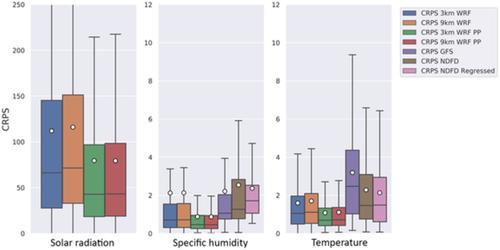当前位置:
X-MOL 学术
›
Meteorol. Appl.
›
论文详情
Our official English website, www.x-mol.net, welcomes your feedback! (Note: you will need to create a separate account there.)
A comparison of statistical and dynamical downscaling methods for short‐term weather forecasts in the US Northeast
Meteorological Applications ( IF 2.7 ) Pub Date : 2021-01-27 , DOI: 10.1002/met.1976 Marc J. Alessi 1, 2 , Arthur T. DeGaetano 1, 3
Meteorological Applications ( IF 2.7 ) Pub Date : 2021-01-27 , DOI: 10.1002/met.1976 Marc J. Alessi 1, 2 , Arthur T. DeGaetano 1, 3
Affiliation

|
The Weather Research and Forecasting model (WRF) was used to produce both 9 and 3 km resolution ensemble forecasts from the deterministic Global Forecast System (GFS) model for microclimatic, agricultural regions in New York State. The forecasts were then statistically post‐processed to generate probabilistic forecasts for surface temperature (T), specific humidity (q), incoming solar radiation (SR) and precipitation (P). T was post‐processed with non‐homogeneous Gaussian regression (NGR), q and SR with truncated NGR, and P with extended logistic regression. A comparison of forecast skill was conducted between these post‐processed forecasts, the raw WRF output, the GFS forecasts and forecasts from the National Weather Service's deterministic National Digital Forecast Database (NDFD). Overall, significant improvement was observed in post‐processed WRF forecasts over all other methods for all locations and variables. Furthermore, raw WRF ensembles were found to outperform deterministic NDFD, so that if observational data are unavailable for post‐processing, dynamically downscaled WRF should be selected over deterministic, human‐altered NDFD forecasts. Finally, the 9 km post‐processed WRF had the same forecast skill as the 3 km post‐processed WRF, except for precipitation, rendering the 3 km WRF unnecessary if observational data are available, saving computational cost.
中文翻译:

统计和动态降尺度方法在美国东北部短期天气预报中的比较
气象研究和预报模型(WRF)用于根据纽约州小气候农业地区的确定性全球预报系统(GFS)模型生成9 km和3 km的分辨率集合预报。然后对这些预测进行统计后处理,以生成有关地表温度(T),比湿度(q),太阳辐射(SR)和降水(P)的概率预测。使用非均质高斯回归(NGR),q和SR以及截短的NGR和P对T进行后处理与扩展的逻辑回归。在这些后处理的预报,原始WRF输出,GFS预报和国家气象局确定性国家数字预报数据库(NDFD)的预报之间进行了预报技巧的比较。总体而言,与所有其他方法相比,后处理的WRF预测在所有位置和变量上都有显着改善。此外,发现原始的WRF集合优于确定性的NDFD,因此,如果观测数据不可用于后处理,则应在确定性的,人为改变的NDFD预测上选择动态缩小的WRF。最后,9 km后处理的WRF具有与3 km后处理的WRF相同的预测技能,除了降水量外,如果有观测数据,则不需要3 km的WRF,
更新日期:2021-01-28
中文翻译:

统计和动态降尺度方法在美国东北部短期天气预报中的比较
气象研究和预报模型(WRF)用于根据纽约州小气候农业地区的确定性全球预报系统(GFS)模型生成9 km和3 km的分辨率集合预报。然后对这些预测进行统计后处理,以生成有关地表温度(T),比湿度(q),太阳辐射(SR)和降水(P)的概率预测。使用非均质高斯回归(NGR),q和SR以及截短的NGR和P对T进行后处理与扩展的逻辑回归。在这些后处理的预报,原始WRF输出,GFS预报和国家气象局确定性国家数字预报数据库(NDFD)的预报之间进行了预报技巧的比较。总体而言,与所有其他方法相比,后处理的WRF预测在所有位置和变量上都有显着改善。此外,发现原始的WRF集合优于确定性的NDFD,因此,如果观测数据不可用于后处理,则应在确定性的,人为改变的NDFD预测上选择动态缩小的WRF。最后,9 km后处理的WRF具有与3 km后处理的WRF相同的预测技能,除了降水量外,如果有观测数据,则不需要3 km的WRF,



























 京公网安备 11010802027423号
京公网安备 11010802027423号